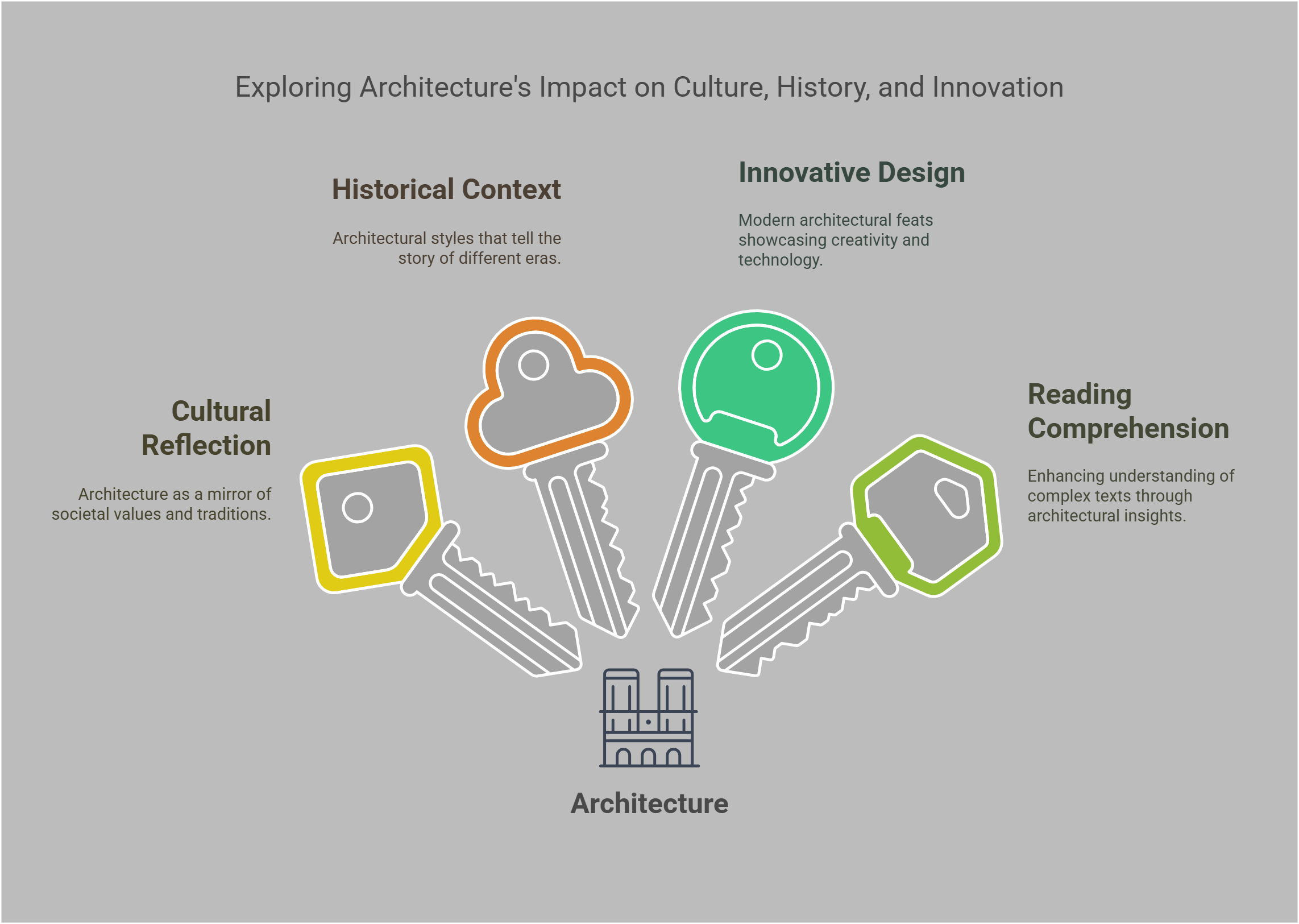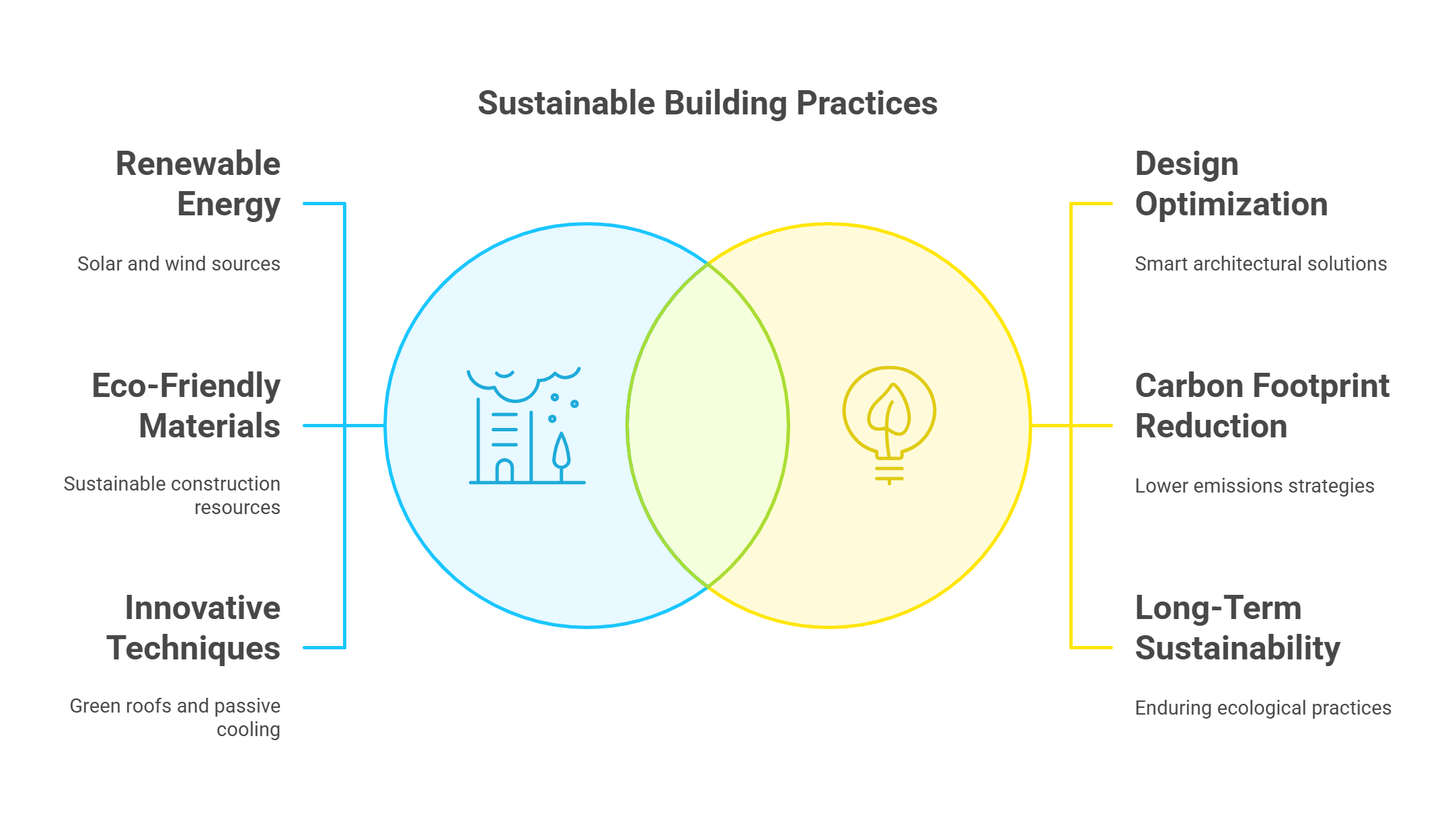🏛️ Architecture: Essential Concepts for Reading Comprehension
Architecture is not just about buildings; it is a reflection of culture, history, and innovation. Understanding architectural concepts can deepen your ability to analyze and interpret Reading Comprehension (RC) passages, which often present intricate discussions on design, sustainability, or urban planning. This subject is crucial for recognizing critical issues, discerning arguments, and appreciating the nuances in passages related to society, environment, and technology.

📋 Overview
In this guide, we’ll explore the following key architecture-related concepts:
- Sustainable Architecture
- Modern Architectural Movements
- Urban Planning
- Architectural Conservation
- Landscape Architecture
- Architectural Design
- Building Materials
- Architectural History
- Interior Design
- Structural Engineering

🔍 Detailed Explanations
1. Sustainable Architecture 🌱
Sustainable architecture focuses on designing buildings that minimize environmental impact and maximize energy efficiency. It incorporates renewable energy sources, eco-friendly materials, and innovative techniques like green roofs and passive cooling.
- Emphasizes environmental responsibility.
- Uses renewable materials and energy-efficient designs.
- Integrates with the natural environment.
- Reduces carbon footprint.
- Promotes long-term sustainability.
Explained Simply: Imagine building a treehouse that doesn’t harm the tree. You use old wood instead of cutting new trees and add solar panels to power lights. It’s like playing with Lego blocks, but you make sure your design is good for the Earth!

2. Modern Architectural Movements 🏗️
Modern architecture emphasizes functionality and simplicity over ornate designs. Movements like Bauhaus and Brutalism focus on clean lines, open spaces, and innovative materials. These styles reflect societal changes, embracing technology and efficiency in the 20th and 21st centuries.
- Prioritizes simplicity and functionality.
- Rejects excessive decoration.
- Incorporates new materials like steel and glass.
- Reflects cultural and technological progress.
- Influences urban and suburban landscapes.
Explained Simply: Think of a house made of big glass windows and metal beams. It’s like a super cool fort where everything is neat and useful—no extra frills, just the stuff you really need!

3. Urban Planning 🏙️
Urban planning is about designing cities to make them efficient, livable, and sustainable. Planners focus on managing resources, traffic, housing, and green spaces to ensure a balanced and organized urban environment.
- Involves designing cities and towns.
- Balances housing, transportation, and green spaces.
- Addresses issues like overcrowding and pollution.
- Promotes economic growth and social well-being.
- Adapts to future urban challenges.
Explained Simply: Imagine planning your room so there’s a spot for your toys, bed, and study table without bumping into everything. Urban planning is like organizing a giant room, but for people in a city!

4. Architectural Conservation 🕰️
Architectural conservation is about preserving historic buildings and sites. This field ensures that structures with cultural, historical, or artistic value remain intact for future generations while adapting them for modern use if necessary.
- Protects cultural heritage.
- Balances preservation and modernization.
- Maintains architectural integrity.
- Supports tourism and education.
- Promotes community identity and pride.
Explained Simply: Think of an old castle that’s falling apart. Instead of letting it crumble, people fix it like a giant puzzle, so everyone can see it for years to come. It’s like saving a storybook so others can read it too!

5. Landscape Architecture 🌳
Landscape architecture involves designing outdoor spaces to be both functional and aesthetically pleasing. This includes parks, gardens, and urban plazas, where natural and human-made elements are combined harmoniously.
- Combines nature with design.
- Improves urban environments through green spaces.
- Balances aesthetics with practicality.
- Reduces environmental impact.
- Enhances community well-being.
Explained Simply: Imagine designing a park with slides, swings, and trees that’s fun for everyone and also good for animals and plants. It’s like drawing a super cool playground that helps the Earth too!

6. Architectural Design ✨
Architectural design is the creative process of planning buildings and structures. It involves balancing functionality, beauty, and safety.
- Combines art, science, and engineering.
- Focuses on functionality and user needs.
- Balances creativity and practicality.
- Applies to diverse types of structures.
- Aims for safety, beauty, and efficiency.
Explained Simply: Think of making a Lego house where you decide how many rooms there are and where the doors and windows go. You make sure it looks cool and doesn’t fall apart when someone plays with it!

7. Building Materials 🧱
Building materials include the physical substances used to construct buildings, such as wood, concrete, steel, and glass. Innovative materials like smart glass and recycled plastics play a key role in modern construction.
- Explores the properties of materials like wood, stone, and steel.
- Focuses on sustainability through recycled materials.
- Examines durability, cost, and environmental impact.
- Includes advances like self-healing concrete and smart glass.
- Key to efficient and long-lasting construction.
Explained Simply: It’s like choosing the best blocks to build a Lego house—some are strong, some look pretty, and some are eco-friendly!

8. Architectural History 📜
Architectural history examines how architecture has evolved over centuries, reflecting cultural, religious, and technological influences. From Gothic cathedrals to modern skyscrapers, each era has unique styles and innovations.
- Traces architectural styles across different eras and regions.
- Explores the influence of religion, culture, and technology.
- Highlights iconic structures like the Taj Mahal and Eiffel Tower.
- Analyzes how history shaped architectural practices.
- Connects the past to modern design innovations.
Explained Simply: It’s like a history book for buildings, showing how people’s ideas about homes and cities have changed over time.

9. Interior Design 🛋️
Interior design focuses on creating functional and aesthetically pleasing indoor spaces. It balances color, furniture, lighting, and layout to enhance comfort and usability.
- Combines functionality with visual appeal.
- Focuses on ergonomics, lighting, and layout.
- Emphasizes the use of colors and materials.
- Explores sustainable and innovative design solutions.
- Links personal style to space efficiency.
Explained Simply: Imagine decorating your room so it’s cozy, looks amazing, and has enough space to play and study. That’s interior design!

10. Structural Engineering 🏛️
Structural engineering ensures that buildings are safe and stable. It involves designing frameworks that can withstand environmental forces like wind, earthquakes, and heavy loads.
- Focuses on the strength and durability of structures.
- Designs frameworks to support buildings and bridges.
- Addresses safety against earthquakes, wind, and loads.
- Incorporates advanced materials and construction methods.
- Works closely with architects to achieve safe designs.
Explained Simply: Structural engineering is like making sure your Lego tower won’t fall when someone bumps the table—it keeps buildings safe and sturdy!

✨ Conclusion
Architecture combines creativity, practicality, and sustainability, offering insights into the challenges of modern society. By understanding these concepts, you’ll not only tackle architecture-based RC passages with ease but also develop the analytical skills to engage with broader topics. Whether it’s discussing sustainable cities or ancient wonders, this knowledge equips you to think critically, interpret arguments, and appreciate the role of design in shaping our world.











